Taxidermy4Cash.com
Charles Darwin

 Darwin's signature, not rare but a personal touch.
Darwin's signature, not rare but a personal touch.
Charles Robert Darwin was born at Shrewsbury, England, in 1809, the son of a well-to-do doctor. His mother died in 1817 when Charles was eight years old. In the following year he was sent to Shrewsbury School, where, to all accounts he was below average in all his subjects. Despite this failure to shine academically at school, as a young child Darwin developed an interest in the natural world becoming a keen collector of bird's eggs, insects and preserved fossils.
From 1825 to 1827 Darwin went to Edinburgh University to follow the family tradition and train as a doctor. Although he gained a degree in medicine Darwin decided against doctoring as a profession due mainly to the fact that he hated seeing illness and he couldn't stand the sight of blood! His Edinburgh years however were significant for, not only did he meet and become friends with Dr Robert Grant, a pioneer evolutionist, sixteen years his senior, (a man who stimulated his interest in rocks and fossils) he gained invaluable knowledge and experience by attending lectures on biology, zoology and chemistry, and learned the skills of taxidermy.
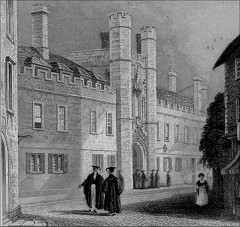 Christ's College, Cambridge as Darwin would have known it
Christ's College, Cambridge as Darwin would have known it
Deciding to become a clergyman in the Established Church, Darwin, in 1828, went to study theology at Christ College, Cambridge. While at the university with the encouragement of Adam Sedgewick, the famous professor of Geology from Dent near Sedbergh and Professor John Henslow, he continued to develop his hobbies in geology and botany.
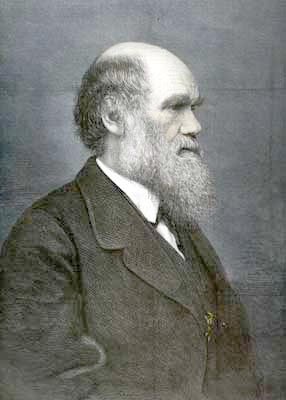 Earlier picture of Charles Darwin aged about 62
Earlier picture of Charles Darwin aged about 62
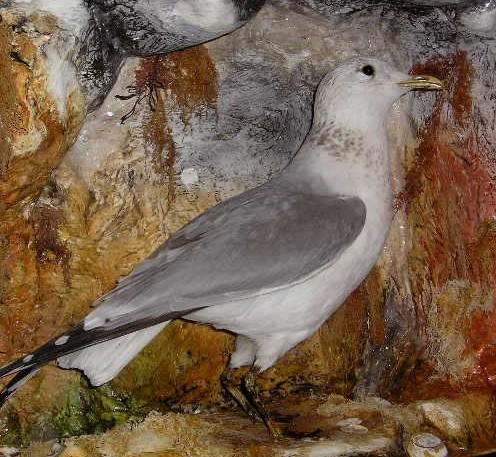 Victorian Common Gull by Shopland of Torquay. Case now returned from the recent Andy Henry dispersal.
Victorian Common Gull by Shopland of Torquay. Case now returned from the recent Andy Henry dispersal.
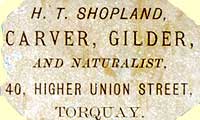 Trade label of Shopland of Torquay from the back of the case above.
Trade label of Shopland of Torquay from the back of the case above.
On graduating in 1831, due to the influence of Henslow, Darwin was offered a position of naturalist on a ship, HMS Beagle, which was about to set off on a voyage to chart the South American coast. After a delay of several months, during which he overcame the disapproval of his father and while the ship was being refitted, the Beagle finally set sail at Christmas of that year setting a course for the Canary Islands; Cape Verde then taking the trade winds to Brazil and Argentina. Stopping for a time at Patagonia Darwin collected several significant fossil remains. The Beagle then set sail for the stormy waters of the Tierra del Fuego and Cape Horn, and then returned to Beunos Aires, thus allowing him more time to explore. As he examined the rocks of the Argentinian hinterland he discovered more fossil remains of animals which resembled creatures living today but larger, different and extinct. When faced with such evidence he came to the conclusion that creation was a continuous process and that it had been going on for a long time. Certainly not a single week as stated in the book of Genesis.
John Edmonstone
John was a freed black slave from Guyana, South America, who made his living in Edinburgh teaching University students the art of taxidermy. He lived at 37 Lothian Street in Edinburgh, just a few doors down from where Charles Darwin and his brother, Erasmus, lived. John learned his trade from Charles Waterton, an early 1800's British naturalist.
While Darwin was a student at Edinburgh University he hired John to teach him taxidermy. The two of them often sat together for conversation and John would fill Darwin's head with vivid pictures of the tropical rain forests of South America. These pleasant conversations with John may have later inspired Darwin to dream about exploring the tropics. In any event, the taxidermy skills Darwin learned from him were indispensable during his voyage aboard H.M.S. Beagle in 1831.
The Beagle continued on its journey. On entering the calmer waters of the Pacific ocean the ship called in at Valparaiso, Chile, where Darwin undertook a six week tour of the Andes. It was while walking in these mountains, at an altitude of 12,000ft, that Darwin found a bed of fossil seashells. This puzzled the young botanist as these fossils had clearly been formed under the sea yet they were found at such a great height above sea level. Totally opposing the prevailing view held by the Creationists that fossil remains like these were found at such a great height because they had been left there by the flood of Genesis, Darwin concluded that they had been marine creatures living and dying in the sea and the rock formed containing such shells had been pushed upwards by tremendous earth movements long ago.
HMS beagle sailed on and reached the Galapagos Islands on 17 September 1835. Here Darwin encountered a host of rare, fascinating if not extraordinary creatures including giant tortoises and Iguanas. It came to Darwin's notice how the majority of birds, reptiles, shells and plants he collected were unique, found only on those islands and nowhere else. In an attempt to explain such variations within one species Darwin rejected the traditional idea of "fixity" - that creation had been instantaneous and fixed - and argued that the animal kingdom had evolved from something very primitive to something complex, and this change was still taking place. Each creature, he reasoned, would change or adapt according to the environment in which it lived and the food available.
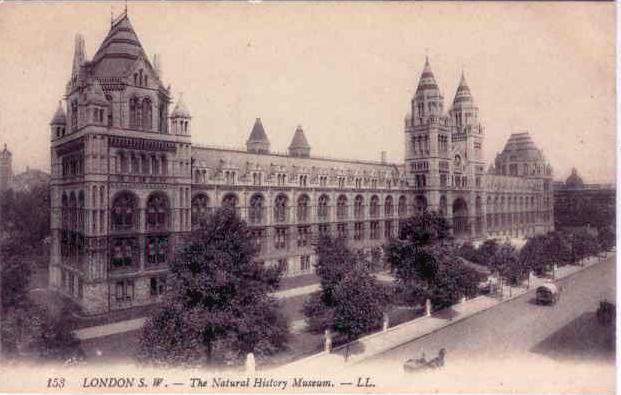 Earlier picture of The Natural History Museum South Kensington. Much of Darwin's collections are now housed here. picture dated 1915.
Earlier picture of The Natural History Museum South Kensington. Much of Darwin's collections are now housed here. picture dated 1915.
Darwin was not unique when he set sail in the Beagle. Indeed Darwin was one of many Victorians who travelled to remote parts of the world in the name of science and exploration. It was not neutral science and exploration, of course, it was frequently in the service of the state or in the interests of capital - in this period ‘naval power, science and empire converged with superb economy’. The late eighteenth and early nineteenth centuries were marked by the growth of science and exploration and the emergence of learned institutions and societies, for example, the Linnean Society (founded 1788), the Royal Society (1799), the Geological Society of London (1807), the Zoological Society of London (1826), the British Association for the Advancement of Science (1831), the Entomological Society (1833), the Edinburgh Botanical Society (1836), the Ethnological Society of London (1843), the Meteorological Office (1845) - with which Robert Fitz Roy was closley associated, and many more again. These societies all needed specimens and were filled with anxious scientists ready to explore, catalogue, record and examine these specimens: ‘the Victorian naturalist’s first duty was to shoot and trap and skin and stuff and pickle, fulfilling through capture and slaughter the role of an imperial Adam’.
It was as if these societies and their members attempted to ‘classify every existing plant, animal and insect’ and no part of the globe was spared a systematic and thorough exploration. Africa was explored by Mungo Park, Richard Lander and Heinrich Barth and even, Darwin’s cousin Francis Galton. The Amazon, which made such an impression of Darwin, had been explored by Henry Bates and Alfred Russel Wallace, and Darwin’s friend and confidant, Joseph Hooker (1817-1911), had explored the Antarctic, Australasia, Africa and the Himalayas in search of plants, and another of Darwin’s friends, Thomas Henry Huxley had sailed as ships surgeon to Australia (and acted as naturalist). Alfred Russel Wallace spent 1854-1862 in the Malay Archipelago and there, contemporaneously with Charles Darwin, discovered evolution through means of natural selection.
The world was shrinking therefore through the efforts of these and other men and the excitement they engendered. The Victorian era also threw up its eccentric explorers, none more peculiar than Mary Kingsley who sallied forth around Africa in everyday English clothes, including parasol, as if she were in Green Park, London. She also wrote the very popular Travels in West Africa (1897). Travel and the exploits of scientists and explorers permanently changed Victorian Britain and its culture. Arthur Conan Doyle’s stories of Sherlock Holmes, for example, are filled with the exotic and the foreign, not surprising since Doyle had been surgeon on ships which sailed to both the Arctic and to Africa. The literature of the late Victorian era is indeed suffused with the effects of this opening up of the world: Rider Haggard’s stories of Africa, Joseph Conrad’s Heart of Darkness, Charles Kingsley’s Water Babies, Samuel Butler’s Erewhon all typify the Victorian world changed by the many contacts with the previously unknown world and its innumerable cultures.
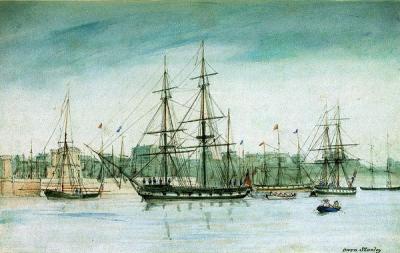
The 235-ton HMS 'Beagle' was launched at the Royal Dockyard, Woolwich on 11 May 1820. She measured just 27 metres (90’4’’) in length, with a breadth of 7 metres (24’6’’). Specially commissioned for the new surveying programme, her career began in 1826 with voyages to Patagonia and Tierra del Fuego under the command of Captain Parker King, returning to Plymouth in 1830. At the end of 1831, she again sailed for South America under the command of Captain Fitzroy. Charles Darwin joined the ship on this voyage as a naturalist. He developed his theories of evolution, culminating in his book 'The Origin of Species', during his time on board. The ship's captain, Robert Fitzroy, was an expert meteorologist who later established the Meteorological Office. The ship suffered a great deal of damage but was extensively refitted and improved throughout her life on the seas, often at great expense to her captain. For example, a mizzenmast was added to make her more manoeuvrable in the shallow coastal waters. In 1845, the ship was left as a watch vessel, and sold to Murray and Trainer in 1870 to be broken up
Darwin's Theory of Evolution - The Premise
Darwin's Theory of Evolution is the widely held notion that all life is related and has descended from a common ancestor: the birds and the bananas, the fishes and the flowers -- all related. Darwin's general theory presumes the development of life from non-life and stresses a purely naturalistic (undirected) "descent with modification". That is, complex creatures evolve from more simplistic ancestors naturally over time. In a nutshell, as random genetic mutations occur within an organism's genetic code, the beneficial mutations are preserved because they aid survival -- a process known as "natural selection." These beneficial mutations are passed on to the next generation. Over time, beneficial mutations accumulate and the result is an entirely different organism (not just a variation of the original, but an entirely different creature.
While Darwin's Theory of Evolution is a relatively young archetype, the evolutionary worldview itself is as old as antiquity. Ancient Greek philosophers such as Anaximander postulated the development of life from non-life and the evolutionary descent of man from animal. Charles Darwin simply brought something new to the old philosophy -- a plausible mechanism called "natural selection." Natural selection acts to preserve and accumulate minor advantageous genetic mutations. Suppose a member of a species developed a functional advantage (it grew wings and learned to fly). Its offspring would inherit that advantage and pass it on to their offspring. The inferior (disadvantaged) members of the same species would gradually die out, leaving only the superior (advantaged) members of the species. Natural selection is the preservation of a functional advantage that enables a species to compete better in the wild. Natural selection is the naturalistic equivalent to domestic breeding. Over the centuries, human breeders have produced dramatic changes in domestic animal populations by selecting individuals to breed. Breeders eliminate undesirable traits gradually over time. Similarly, natural selection eliminates inferior species gradually over time.
Uniformitarian theory became more popular as Darwin's theory of evolution through natural selection became popular. Like Darwin's theories, the work of Sir Charles Lyell provided logical, rational explanations that suited the beliefs of many scientists. Over time, those explanations were considered proofs, and nowadays the scientific community at large accepts Lyell's explanations for rock layers and other geological effects with little question.
The relationship between Lyell's work and Darwin's work foreshadowed an aspect of human science still active today. Darwin accepted Lyell's work, in large part, because it helped him to validate his own beliefs. There were other geological studies that undermined Darwin's ideas, but he chose not to accept them. Lyell himself, ironically, was reluctant to accept Darwin's model of evolution because he did not see evidence to support it. In much the same way, some scientific evidence is applauded by a community when it supports the beliefs they already have. Evidence, even when valid, that goes against this belief is either ignored or attacked as being "unscientific."
A perfect example to illustrate the fallacy of this self-imposed blindness is the battle between uniformitarianism and catastrophism. Since catastrophism was associated, to some degree, with religious beliefs, it fell quickly out of favor with scientists who preferred not to believe in Creation. Uniformitarianism presented a view that was more compatible with a naturalistic, very old world. There was evidence for both, yet scientists considered catastrophism "less scientific." In recent years, science has swung back towards catastrophism somewhat, due to the inability of a uniform-cause view to explain certain geological and biological realities.
It is critical to remember that an explanation may be logical, comprehensive, and have supporting data, yet still be wrong. The back-and-forth swing between these theories, as with other major discoveries throughout history, emphasizes that human beings have a tendency to believe first and find facts to fit their beliefs later. The enabling aspect of Sir Charles Lyell's work in relationship to Charles Darwin highlights the tendency for human beings, even scientists, to accept reasons and explanations based on preference, more than merit.
Darwin's field notes (extract) on Galapagos Archipelago September 15th 1831
SEPTEMBER 15th. - This archipelago consists of ten principal islands, of which five exceed the others in size. They are situated under the Equator, and between five and six hundred miles westward of the coast of America. They are all formed of volcanic rocks; a few fragments of granite curiously glazed and altered by the heat, can hardly be considered as an exception. Some of the craters, surmounting the larger islands, are of immense size, and they rise to a height of between three and four thousand feet. Their flanks are studded by innumerable smaller orifices. I scarcely hesitate to affirm, that there must be in the whole archipelago at least two thousand craters. These consist either of lava or scoriae, or of finely- stratified, sandstone-like tuff. Most of the latter are beautifully symmetrical; they owe their origin to eruptions of volcanic mud without any lava: it is a remarkable circumstance that every one of the twenty-eight tuff-craters which were examined, had their southern sides either much lower than the other sides, or quite broken down and removed. As all these craters apparently have been formed when standing in the sea, and as the waves from the trade wind and the swell from the open Pacific here unite their forces on the southern coasts of all the islands, this singular uniformity in the broken state of the craters, composed of the soft and yielding tuff, is easily explained.
Considering that these islands are placed directly under the equator, the climate is far from being excessively hot; this seems chiefly caused by the singularly low temperature of the surrounding water, brought here by the great southern Polar current. Excepting during one short season, very little rain falls, and even then it is irregular; but the clouds generally hang low. Hence, whilst the lower parts of the islands are very sterile, the upper parts, at a height of a thousand feet and upwards, possess a damp climate and a tolerably luxuriant vegetation. This is especially the case on the windward sides of the islands, which first receive and condense the moisture from the atmosphere.
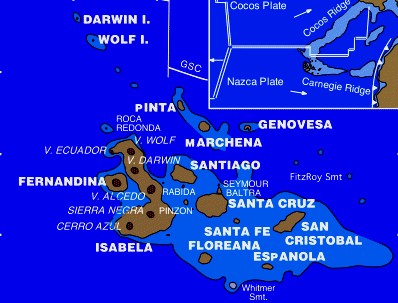 Galapogos Islands
Galapogos Islands
In the morning (17th) we landed on Chatham Island, which, like the others, rises with a tame and rounded outline, broken here and there by scattered hillocks, the remains of former craters. Nothing could be less inviting than the first appearance. A broken field of black basaltic lava, thrown into the most rugged waves, and crossed by great fissures, is everywhere covered by stunted, sun-burnt brushwood, which shows little signs of life. The dry and parched surface, being heated by the noon-day sun, gave to the air a close and sultry feeling, like that from a stove: we fancied even that the bushes smelt unpleasantly. Although I diligently tried to collect as many plants as possible, I succeeded in getting very few; and such wretched-looking little weeds would have better become an arctic than an equatorial Flora. The brushwood appears, from a short distance, as leafless as our trees during winter; and it was some time before I discovered that not only almost every plant was now in full leaf, but that the greater number were in flower. The commonest bush is one of the Euphorbiaceae: an acacia and a great odd-looking cactus are the only trees which afford any shade. After the season of heavy rains, the islands are said to appear for a short time partially green. The volcanic island of Fernando Noronha, placed in many respects under nearly similar conditions, is the only other country where I have seen a vegetation at all like this of the Galapagos Islands.
The Beagle sailed round Chatham Island, and anchored in several bays. One night I slept on shore on a part of the island, where black truncated cones were extraordinarily numerous: from one small eminence I counted sixty of them, all surmounted by craters more or less perfect. The greater number consisted merely of a ring of red scoriae or slags, cemented together: and their height above the plain of lava was not more than from fifty to a hundred feet; none had been very lately active. The entire surface of this part of the island seems to have been permeated, like a sieve, by the subterranean vapours: here and there the lava, whilst soft, has been blown into great bubbles; and in other parts, the tops of caverns similarly formed have fallen in, leaving circular pits with steep sides. From the regular form of the many craters, they gave to the country an artificial appearance, which vividly reminded me of those parts of Staffordshire, where the great iron-foundries are most numerous. The day was glowing hot, and the scrambling over the rough surface and through the intricate thickets, was very fatiguing; but I was well repaid by the strange Cyclopean scene. As I was walking along I met two large tortoises, each of which must have weighed at least two hundred pounds: one was eating a piece of cactus, and as I approached, it stared at me and slowly walked away; the other gave a deep hiss, and drew in its head. These huge reptiles, surrounded by the black lava, the leafless shrubs, and large cacti, seemed to my fancy like some antediluvian animals. The few dull- coloured birds cared no more for me than they did for the great tortoises.
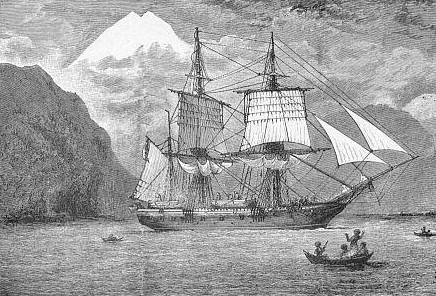 HMS Beagle in the Galapogos Islands, 1831
HMS Beagle in the Galapogos Islands, 1831
23rd. - The Beagle proceeded to Charles Island. This archipelago has long been frequented, first by the bucaniers, and latterly by whalers, but it is only within the last six years, that a small colony has been established here. The inhabitants are between two and three hundred in number; they are nearly all people of colour, who have been banished for political crimes from the Republic of the Equator, of which Quito is the capital. The settlement is placed about four and a half miles inland, and at a height probably of a thousand feet. In the first part of the road we passed through leafless thickets, as in Chatham Island. Higher up, the woods gradually became greener; and as soon as we crossed the ridge of the island, we were cooled by a fine southerly breeze, and our sight refreshed by a green and thriving vegetation. In this upper region coarse grasses and ferns abound; but there are no tree-ferns: I saw nowhere any member of the palm family, which is the more singular, as 360 miles northward, Cocos Island takes its name from the number of cocoa-nuts. The houses are irregularly scattered over a flat space of ground, which is cultivated with sweet potatoes and bananas. It will not easily be imagined how pleasant the sight of black mud was to us, after having been so long, accustomed to the parched soil of Peru and northern Chile. The inhabitants, although complaining of poverty, obtain, without much trouble, the means of subsistence. In the woods there are many wild pigs and goats; but the staple article of animal food is supplied by the tortoises. Their numbers have of course been greatly reduced in this island, but the people yet count on two days' hunting giving them food for the rest of the week. It is said that formerly single vessels have taken away as many as seven hundred, and that the ship's company of a frigate some years since brought down in one day two hundred tortoises to the beach.
September 29th. - We doubled the south-west extremity of Albemarle Island, and the next day were nearly becalmed between it and Narborough Island. Both are covered with immense deluges of black naked lava, which have flowed either over the rims of the great caldrons, like pitch over the rim of a pot in which it has been boiled, or have burst forth from smaller orifices on the flanks; in their descent they have spread over miles of the sea-coast. On both of these islands, eruptions are known to have taken place; and in Albemarle, we saw a small jet of smoke curling from the summit of one of the great craters. In the evening we anchored in Bank's Cove, in Albemarle Island. The next morning I went out walking. To the south of the broken tuff-crater, in which the Beagle was anchored, there was another beautifully symmetrical one of an elliptic form; its longer axis was a little less than a mile, and its depth about 500 feet. At its bottom there was a shallow lake, in the middle of which a tiny crater formed an islet. The day was overpoweringly hot, and the lake looked clear and blue: I hurried down the cindery slope, and, choked with dust, eagerly tasted the water - but, to my sorrow, I found it salt as brine.
The rocks on the coast abounded with great black lizards, between three and four feet long; and on the hills, an ugly yellowish-brown species was equally common. We saw many of this latter kind, some clumsily running out of the way, and others shuffling into their burrows. I shall presently describe in more detail the habits of both these reptiles. The whole of this northern part of Albemarle Island is miserably sterile.
October 8th. - We arrived at James Island: this island, as well as Charles Island, were long since thus named after our kings of the Stuart line. Mr. Bynoe, myself, and our servants were left here for a week, with provisions and a tent, whilst the Beagle went for water. We found here a party of Spaniards, who had been sent from Charles Island to dry fish, and to salt tortoise-meat. About six miles inland, and at the height of nearly 2000 feet, a hovel had been built in which two men lived, who were employed in catching tortoises, whilst the others were fishing on the coast. I paid this party two visits, and slept there one night. As in the other islands, the lower region was covered by nearly leafless bushes, but the trees were here of a larger growth than elsewhere, several being two feet and some even two feet nine inches in diameter. The upper region being kept damp by the clouds, supports a green and flourishing vegetation. So damp was the ground, that there were large beds of a coarse cyperus, in which great numbers of a very small water-rail lived and bred. While staying in this upper region, we lived entirely upon tortoise-meat: the breast-plate roasted (as the Gauchos do _carne con cuero_), with the flesh on it, is very good; and the young tortoises make excellent soup; but otherwise the meat to my taste is indifferent.
One day we accompanied a party of the Spaniards in their whale-boat to a salina, or lake from which salt is procured. After landing, we had a very rough walk over a rugged field of recent lava, which has almost surrounded a tuff-crater, at the bottom of which the salt-lake lies. The water is only three or four inches deep, and rests on a layer of beautifully crystallized, white salt. The lake is quite circular, and is fringed with a border of bright green succulent plants; the almost precipitous walls of the crater are clothed with wood, so that the scene was altogether both picturesque and curious. A few years since, the sailors belonging to a sealing-vessel murdered their captain in this quiet spot; and we saw his skull lying among the bushes.
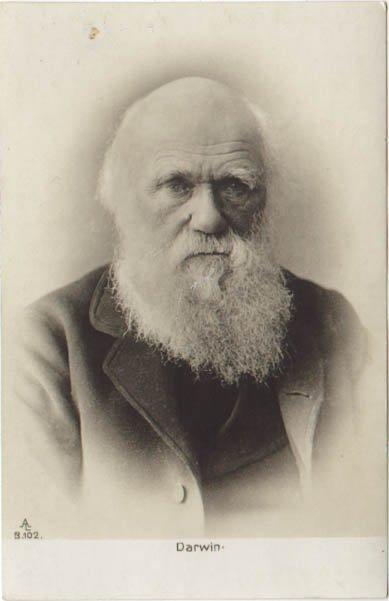 Picture of Charles Darwin just before his death.
Picture of Charles Darwin just before his death.
During the greater part of our stay of a week, the sky was cloudless, and if the trade-wind failed for an hour, the heat became very oppressive. On two days, the thermometer within the tent stood for some hours at 93 degs.; but in the open air, in the wind and sun, at only 85 degs. The sand was extremely hot; the thermometer placed in some of a brown colour immediately rose to 137 degs., and how much above that it would have risen, I do not know, for it was not graduated any higher. The black sand felt much hotter, so that even in thick boots it was quite disagreeable to walk over it.
The natural history of these islands is eminently curious, and well deserves attention. Most of the organic productions are aboriginal creations, found nowhere else; there is even a difference between the inhabitants of the different islands; yet all show a marked relationship with those of America, though separated from that continent by an open space of ocean, between 500 and 600 miles in width. The archipelago is a little world within itself, or rather a satellite attached to America, whence it has derived a few stray colonists, and has received the general character of its indigenous productions. Considering the small size of the islands, we feel the more astonished at the number of their aboriginal beings, and at their confined range. Seeing every height crowned with its crater, and the boundaries of most of the lava- streams still distinct, we are led to believe that within a period geologically recent the unbroken ocean was here spread out. Hence, both in space and time, we seem to be brought somewhat near to that great fact - that mystery of mysteries - the first appearance of new beings on this earth.
Of terrestrial mammals, there is only one which must be considered as indigenous, namely, a mouse (Mus Galapagoensis), and this is confined, as far as I could ascertain, to Chatham Island, the most easterly island of the group. It belongs, as I am informed by Mr. Waterhouse, to a division of the family of mice characteristic of America. At James Island, there is a rat sufficiently distinct from the common kind to have been named and described by Mr. Waterhouse; but as it belongs to the old-world division of the family, and as this island has been frequented by ships for the last hundred and fifty years, I can hardly doubt that this rat is merely a variety produced by the new and peculiar climate, food, and soil, to which it has been subjected. Although no one has a right to speculate without distinct facts, yet even with respect to the Chatham Island mouse, it should be borne in mind, that it may possibly be an American species imported here; for I have seen, in a most unfrequented part of the Pampas, a native mouse living in the roof of a newly built hovel, and therefore its transportation in a vessel is not improbable: analogous facts have been observed by Dr. Richardson in North America.
Charles Darwin
He died at Downe on 19 April 1882.
The Dean of Westminster, George Granville Bradley, was away in France when he received a telegram forwarded from the President of the Royal Society in London saying “…it would be acceptable to a very large number of our fellow-countrymen of all classes and opinions that our illustrious countryman, Mr Darwin, should be buried in Westminster Abbey”. The Dean recalled “ I did not hesitate as to my answer and telegraphed direct…that my assent would be cheerfully given”. The body lay overnight in the Abbey, in the small chapel of St Faith, and on the morning of 26 April the coffin was escorted by the family and eminent mourners into the Abbey. The pall-bearers included Sir Joseph Hooker, Alfred Russel Wallace, James Russell Lowell (U.S. Ambassador), and William Spottiswoode (President of the Royal Society). The burial service was held in the Lantern, conducted by Canon Prothero, with anthems sung by the choir. The chief mourners then followed the coffin into the north aisle of the Nave where Darwin was buried next to the eminent scientist Sir John Herschel, and a few feet away from Sir Isaac Newton. The simple inscription on his grave reads “CHARLES ROBERT DARWIN BORN 12 FEBRUARY 1809. DIED 19 APRIL 1882”. Although an agnostic, Darwin was greatly respected by his contemporaries and the Bishop of Carlisle, Harvey Goodwin, in a memorial sermon preached in the Abbey on the Sunday following the funeral, said “I think that the interment of the remains of Mr Darwin in Westminster Abbey is in accordance with the judgment of the wisest of his countrymen…It would have been unfortunate if anything had occurred to give weight and currency to the foolish notion which some have diligently propagated, but for which Mr Darwin was not responsible, that there is a necessary conflict between a knowledge of Nature and a belief in God…”. A later, widely believed, rumour of a “deathbed conversion” to Christianity was denied by his daughter, who was actually present at his death. A bronze memorial, with a life-sized relief bust, was erected by his family in the north choir aisle, near to the grave, in 1888. The sculptor was Sir J.E. Boehm. The inscription just says simply “DARWIN”.
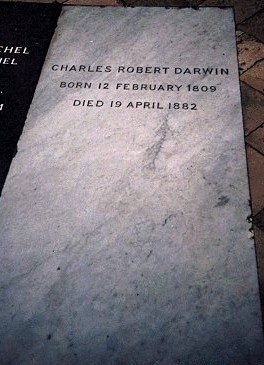 Charles Robert Darwin 1809-1882
Charles Robert Darwin 1809-1882
Taxidermy4Cash does not undertake taxidermy, rather we are collectors of
other people’s work, both current and historical we also offer web hosting,
a search engine submission service and increasingly one of the larger
article resource banks on the net. So if your keen to learn about Taxidermy
etc, then you know where to look.
We are always interested to here about new resource, if you feel a resource
should be listed here then please contact us.
Copyright TAXIDERMY4CASH 2004. Use of any material contained within this webite (pictures / text / figures) for commercial and non purposes is expressly prohibited unless permission is obtained from the copyright holder.
|
ITEMS
WANTED. Please respond via this on-line form HERE
with a description of what you have for sale.
[HOMEPAGE]
Taxidermy Links.
Please double click on the Taxidermy link icon below.
Taxidermy
Links
|
|












